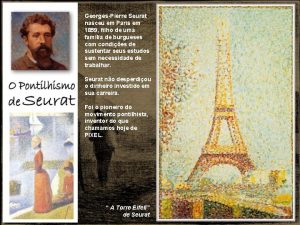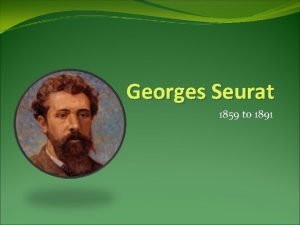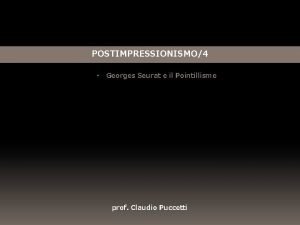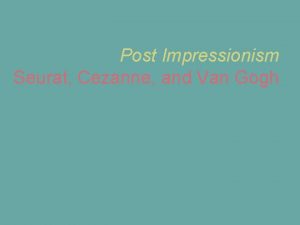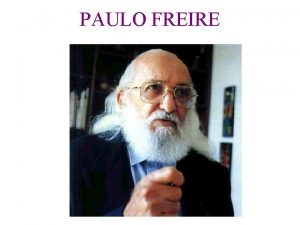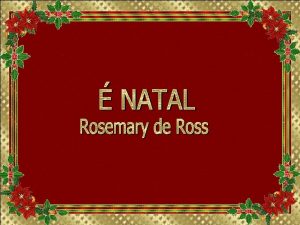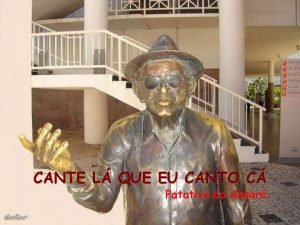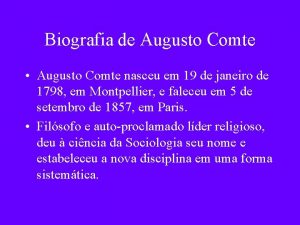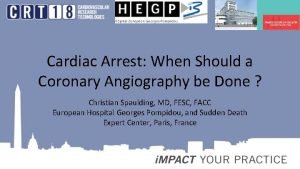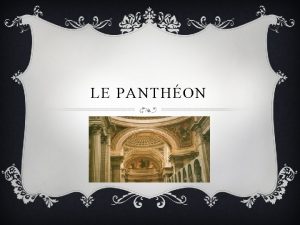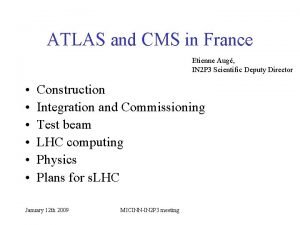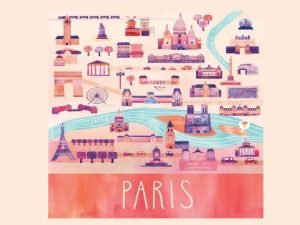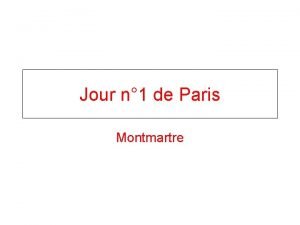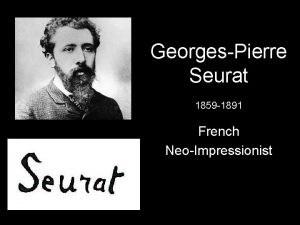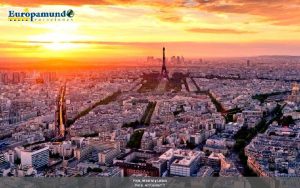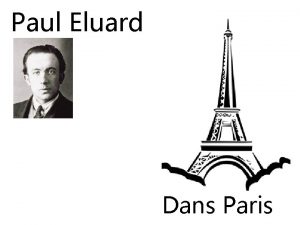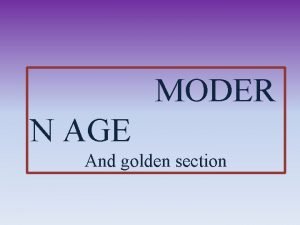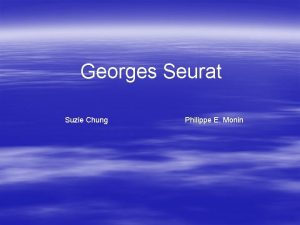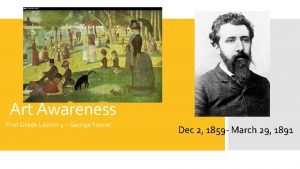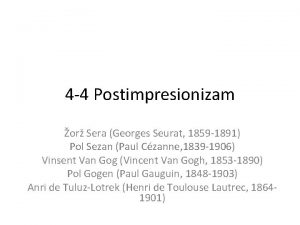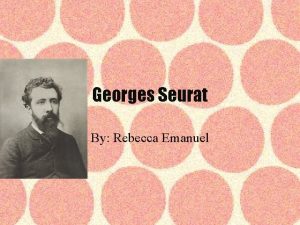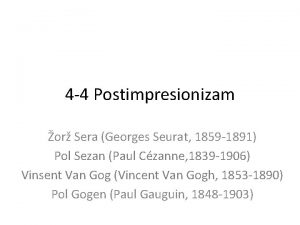GeorgesPierre Seurat nasceu em Paris em 2 de


































- Slides: 34


Georges-Pierre Seurat nasceu em Paris em 2 de dezembro de 1859. Foi um pintor francês, pioneiro do movimento Pontilhista, também chamado Divisionismo. Após estudar em algumas escolas de desenho, Seurat ingressou, em 1877, na “École des Beaux-Arts ” de Paris. Seus estudos foram interrompidos por um ano pelo serviço militar na base de Brest - uma cidade do oeste francês onde fez numerosos esboços de barcos, de praias e do mar. Em 1880, de volta a Paris, Seurat se torna “Mirrestro”, inspirado pela obra de Michel Eugène Chevreul: a lei do contraste simultâneo das cores. A técnica do pontilhismo utilizada por Seurat deu origem ao Neo-Impressionismo e foi extensivamente utilizada na Arte do século XX. Pode-se dizer que a teoria Pontilhista foi precursora da televisão e da imagem digital. Esta técnica consiste em separar as cores nas suas componentes, de maneira que, em vez de serem misturadas como pigmentos e aplicadas à tela, são misturadas pelo olhar, desde que as vejamos à distância certa.

Seurat interessou-se tanto pelo estudo dos grandes mestres quanto pelas investigações no campo da ótica e geometria aplicadas à pintura. Tal como Mondrian e Leonardo da Vinci, Seurat também recorreu à técnica da simetria dinâmica usando retângulos de ouro nas suas pinturas. Sua tela, “A Sunday Afternoon on the Island of La Grande Jatte”, é o marco inicial do movimento Neo-Impressionista francês. Em 1884, tendo seus quadros recusados pelo tradicional “Salon” de Paris, Seurat desprezou a Arte acadêmica do “Salon” e aliou-se aos jovens pintores independentes. Organizaram exposições de Arte voltadas para novas tendências estéticas, sendo que primeira exposição do grupo, no Salão dos Independentes, ocorreu nesse mesmo ano, o que ajudou a difundir as ideias do Neo. Impressionismo. Seurat morreu em Paris, em 29 de março de 1891. Na época de seu falecimento, o artista pintava a obra “The Circus”, deixada inacabada. Angelica at the Rock, 1878

Sunset, 1881 - Bristol Museum and Art Gallery, England

Fisherman in a Moored Boat, 1882 - Courtauld Institute Galleries, London, UK

Rock-Breakers, Le Raincy, c. 1882 - Norton Simon Art Foundation, Pasadena, CA, USA

Ville d’Avray, France, Maisons Blanches, 1882 - National Museums Liverpool

Horse in a Field, c. 1882 - The Guggenheim Museum, New York, USA

Boy Sitting in a Meadow, 1882 -83 - Glasgow Museums Pierrot with a White Pipe, 1883 Private Collection

House among Trees, 1883 - Glasgow Museums

Boat by the Bank, Asnières, 1883 - Courtauld Institute Galleries, London, UK

Horses in the Water, 1883 - Courtauld Institute Galleries, London, UK

Man Painting a Boat, 1883 - Courtauld Institute Galleries, London, UK

Man in a Boat, 1884 - Courtauld Institute Galleries, London, UK

Bathers at Asnières, 1884 - National Gallery, London

A Sunday Afternoon on the Island of La Grande Jatte, 1884– 86 - The Art Institute of Chicago

The Rue St. Vincent, Paris in Spring, 1884 The Fitzwilliam Museum, Cambridge, UK Angler, 1884 Courtauld Institute Galleries, London, UK

View of Fort Samson 1885 - Hermitage Museum, St. Petersburg, Russia

La Rade de Grandcamp, 1885 - Tate Gallery, London, UK

The Morning Walk, 1885 The National Gallery, London La Siene a Courbevoie, c. 1885 -86 Private Collection

La Maria, Honfleur, 1886 - Narodni Gallery, Prague, Czech Republic

Port of Honfleur, 1886 - Barnes Foundation, Merion, Pennsylvania, USA

The Bridge at Courbevoie, 1886 -87 - Courtauld Institute Galleries, London, UK

Circus Sideshow (or Parade de Cirque), 1887 -88 - Metropolitan Museum of Art, New York

Port-en-Bessin, 1888 - Musée d’Orsay, Paris, France

Gray Weather, Grande Jatte, 1888 - Philadelphia Museum of Art, USA

Port-en-Bessin, 1888 - The Minneapolis Institute of Arts, Minneapolis, USA

The Seine and la Grande Jatte - Springtime, 1888 - Royal Museums of Fine Arts, Belgium

The Models, 1888 - Barnes Foundation, Merion, PA, USA

The Eiffel Tower, 1889 Fine Art Museum of San Francisco, USA Le Chahut, 1889 -90 Kröller-Müller Museum, Otterlo, Netherlands

Biography: Georges-Pierre Seurat was born in Paris, on December 2, 1859. He was a French painter and a pioner of the Pointillist movement, also known as Divisionism. After studying in some drawing schools, Seurat entered, in 1877, in the “École des Beaux-Arts” in Paris. His studies were interrupted for a year by the military service in the base of Brest - a city in the Western France - where he made numerous sketches of boats, beaches and the sea. Seurat came back to Paris in 1880, when he became a “Mirrestro”, inspired by the work of Michel Eugène Chevreul: the law of simultaneous contrast of colors. The technique of Pointillism used by Serat was the base to Neo-Impressionism and was largely used in the Art of the twentieth century. It can be said that theory of Pointillism was the precursor of television and digital image. This technique consists in separating colors in its components, so that, instead of to be blended as pigments and applied to the screen, they look mixed, since we see them in a right distance. La Parade, 1889 (detail showing pointillism technique)

Seurat was interested in both the study of the great masters as the investigations in the field of optica and geometry applied to painting. Like Mondrian and Leonardo da Vinci, Seurat also resorted to the technique of the dinamic simmetry, and used golden rectangles in his paintings. His work “A Sunday Afternoon on the Island of La Grande Jatte” is the initial movement of French Neo-Impressionism. In 1884, with his paintings refused by the traditional “Salon” of Paris, Seurat despised the Academic Art of the “Salon” and teamed up with the independent young painters. They organized Art exhibitions facing to new aesthetic trends, and the first group exhibition in the “Salon of Independents”, in this same year, helped to difuse the ideas of Neo-Impressionism. Seurat died in Paris on March 29, 1891. At the time of his death, the artist was painting “The Circus”, what was left unfinished. Young Woman Powdering Herself, 1890 Courtauld Institute Galleries, London, UK

Créditos Música: Phidylé Henri Duparc, 1848 -1933 Pesquisa e Formatação: Julia Zappa juliazappa@uol. com. br Revisão e Tradução de Texto: Ida Aranha sabercultural@sabercultural. com http: //www. sabercultural. org Outubro 2013 The Circus, 1891 - Musée d’Orsay, Paris, France

The Artist’s Mother Metropolitan Museum of Art, New York Fontes: http: //en. wikipedia. org/wiki/Georges_Seurat http: //www. abcgallery. com/S/seurat. html http: //www. tate. org. uk/artists/georges-seurat-1926 http: //www. metmuseum. org/toah/hd/seni/hd_seni. htm http: //www. renoirinc. com/biography/artists/seurat. htm http: //www. educ. fc. ul. pt/icm 2000/icm 33/Seurat. htm http: //www. biography. com/people/georges-seurat-9479599 http: //www. bbc. co. uk/arts/yourpaintings/artists/georges-seurat http: //abstracaocoletiva. com. br/2013/01/26/georges-seurat-biografia/ Eden Concert Van Gogh Museum, Amsterdam
 Nasceu em paris em 1859
Nasceu em paris em 1859 Magritte i principi dell'autunno
Magritte i principi dell'autunno Agnes peter stamm analyse
Agnes peter stamm analyse Chahut seurat
Chahut seurat Art critique sample
Art critique sample Georges seurats
Georges seurats Seurat pointillisme
Seurat pointillisme Picasso rembrandt van gogh
Picasso rembrandt van gogh Seurat penjodoh bilangan
Seurat penjodoh bilangan Seurat and cezanne
Seurat and cezanne Onde nasceu o pintor e compositor lasar segall
Onde nasceu o pintor e compositor lasar segall Paulo freire nasceu em recife em 1921
Paulo freire nasceu em recife em 1921 Natal tempo de luz
Natal tempo de luz Poeta cantor de rua que na cidade nasceu
Poeta cantor de rua que na cidade nasceu Uma flor nasceu no asfalto
Uma flor nasceu no asfalto Em belem nasceu jesus nosso grande redentor
Em belem nasceu jesus nosso grande redentor Principais fabulistas
Principais fabulistas Da flor nasceu maria
Da flor nasceu maria Paulo freire nasceu
Paulo freire nasceu Biografia de augusto comte
Biografia de augusto comte Michelangelo di lodovico buonarroti simoni
Michelangelo di lodovico buonarroti simoni Paris and friar lawrence
Paris and friar lawrence Ecmo paris subway
Ecmo paris subway Le pantheon facts
Le pantheon facts En parís está doña alda
En parís está doña alda How tall is the eiffel tower in paris france
How tall is the eiffel tower in paris france Paris saclay
Paris saclay Paris japonica
Paris japonica Manuele kirsch pinheiro
Manuele kirsch pinheiro Slab in orthopedics
Slab in orthopedics Quilles de huit
Quilles de huit Von paris
Von paris Paris is divided into 20
Paris is divided into 20 Cbd paris montmartre
Cbd paris montmartre Rer pass carmillon
Rer pass carmillon
